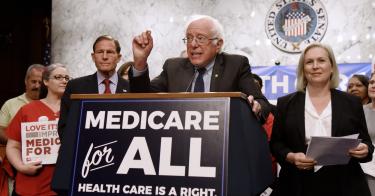Americans face a stark choice on what their health care will look like in the future.
They can adopt a government-run health-care system, financed by new and heavy federal taxation, with federal officials making all the key decisions about medical benefits and services. Or, they can adopt a system in which individuals control health-care dollars and decisions, including the kinds of health plans, benefits and treatments that best suit their needs.
Option one, commonly referred to as a “single payer system,” makes health care a government monopoly. Option two, based on personal choice, relies on voluntary collaboration and competition among plans and providers to control health care costs.
Today, we have neither.
What we have is a highly bureaucratic system: one in which the government controls financing for roughly half of U.S. health care; one in which personal choice and competition are rapidly declining; one in which the health-care costs are excessive. Additionally, federal officials are exercising detailed regulatory control over health plans, benefits and even the practice of medicine itself.
Despite President Obama’s insistence that Obamacare would not be a government “takeover” of health care, hardly any component of American health care today, courtesy of Obamacare, is insulated from federal regulation and control. Given the general direction of current policy, the trajectory is toward a single-payer system, not away from it.
Sen. Bernie Sanders, with the cosponsorship of sixteen Senate Democrats, has decided to give the current drift to a government monopoly a giant shove by introducing “The Medicare for All Act of 2017.” The bill would replace private health insurance, including employer-sponsored health insurance, with a new and expanded version of the traditional Medicare program.
Rep. John Conyers has already introduced a similar “Medicare for All” bill, cosponsored by 117 House Democrats, more than half of all Democrats in the lower chamber.
Meanwhile, on the West Coast, liberal politicians in California are pushing a statewide “single-payer program.” If enacted, the Healthy California Act would displace existing private- and employer-based coverage, as well as Medicare and Medicaid. It would also impose a new 15 percent payroll tax to help cover its estimated annual cost of $400 billion.
Economists and health-policy specialists will spend the next few weeks and months analyzing Sanders’ bill. At the end of that process, we should have a pretty clear idea of how this particular proposal will affect doctors, patients and taxpayers.
But we can already predict some of the economic consequences, at least in general terms. That’s because imposition of a government health-care monopoly—be it in the form of the Medicare fee-for-service system, the British National Health Service or the Canadian health system—has certain economic features in common.
First, such a system will rely on broad-based taxation, usually in the form of some sort of payroll tax. For example, liberals in Colorado pushed a single-payer initiative in 2016 to be financed by a 10 percent payroll tax, but it failed at the ballot box. Sen. Sanders has proposed a number of “options” to finance his proposal: a 7.5 percent payroll tax on employers, plus a 4 percent “income-based premium” on all Americans, the elimination of the tax breaks on employer-sponsored health insurance, and a series of new taxes on the wealthy.
Last year, Sanders proposed a more modest 6.2 percent employer payroll tax, plus a 2.2 percent universal income tax, as new taxes on “the rich.” A 2016 analysis of that proposal by Emory University Professor Kenneth Thorpe concluded:
The new tax burden would vary dramatically by income. Low-income working families would pay 2.2 percent of taxable income and face a 6.2 percent reduction in wages traced to the employer payroll tax. Individuals and families earning over $250,000 would face a 40 percent increase in taxes to finance the plan and pay for most of the new costs of the plan.
Second, the program costs will surely outrun the official projections. In his analysis of the earlier version of Sanders’ bill, Thorpe estimated that the program’s cost would average $2.5 trillion a year, “creating an average of over $1 trillion per year financing shortfall.” Such a program deficit, Thorpe observed, would require even higher taxes: “To fund the program, payroll and income taxes would have to increase from a combined 8.4 percent in the Sanders plan to 20 percent while also retaining all remaining tax increases on capital gains, increased marginal tax rates, the estate tax and eliminating tax expenditures.”
Alternatively, of course, government officials, under such a program, could set and enforce tough health-care budgets. In practice, exercises in government cost control often take the form of old-fashioned price controls or periodic payment cuts to doctors, hospitals or other medical professionals.
The little problem, of course, is that payment reductions for medical services always affect the patients who need those services. Cost control through budgetary limitations or medical-payment cuts typically reduces the access that patients have to treatment, starting with progressively longer waiting lists.
Third, the program will not be a model of simplicity. Sanders insists that the beauty of his proposal is that it will simplify American health care. This is nonsense. There is nothing simple about Medicare, and the nature of the diverse demand for medical services guarantees its regulatory complexity.
Government officials cannot control the demand for medical services; they can only control the supply of medical goods and services. In practice, this means that government officials must determine what kind of care patients get, how they get it, under what circumstances they get it, and how those services will be “priced.” (They don’t negotiate prices; they fix them.)
There is nothing “simple” about any of this. The Medicare program, with its tens of thousands of pages of rules and regulations and guidelines, demonstrates that painful fact daily to any Medicare patient struggling with a Medicare claims denial, or any doctor or any other medical professional wrestling with Medicare paperwork. Meanwhile, forget personal freedom.
Not surprisingly, the Senate Republicans’ abysmal failure to enact a health-reform bill has been the main catalyst for the renewed vitality of Sanders’ program. His proposal can no longer be dismissed as a product of the far Left. Sen. Elizabeth Warren recently declared that the “progressives” are now the “heart and soul” of the Democratic Party, and the recent embrace of the Sanders health-policy agenda by senior Senate Democrats and a majority of House Democrats reflects that fact. In her interview with the Wall Street Journal, Warren said that, “Now it’s time for the next step. And the next step is single payer.”
Congressional liberals have a clear vision of health care. They know just where they want to take America. Their agenda is based on is heavier taxation, higher federal spending, larger government programs and ever greater government control over the economy.
Congressional conservatives need to offer America something better: a positive vision of health reform based on personal freedom, choice and voluntary collaboration. They need to get back to work, and back in the game.
This piece originally appeared in National Interest




